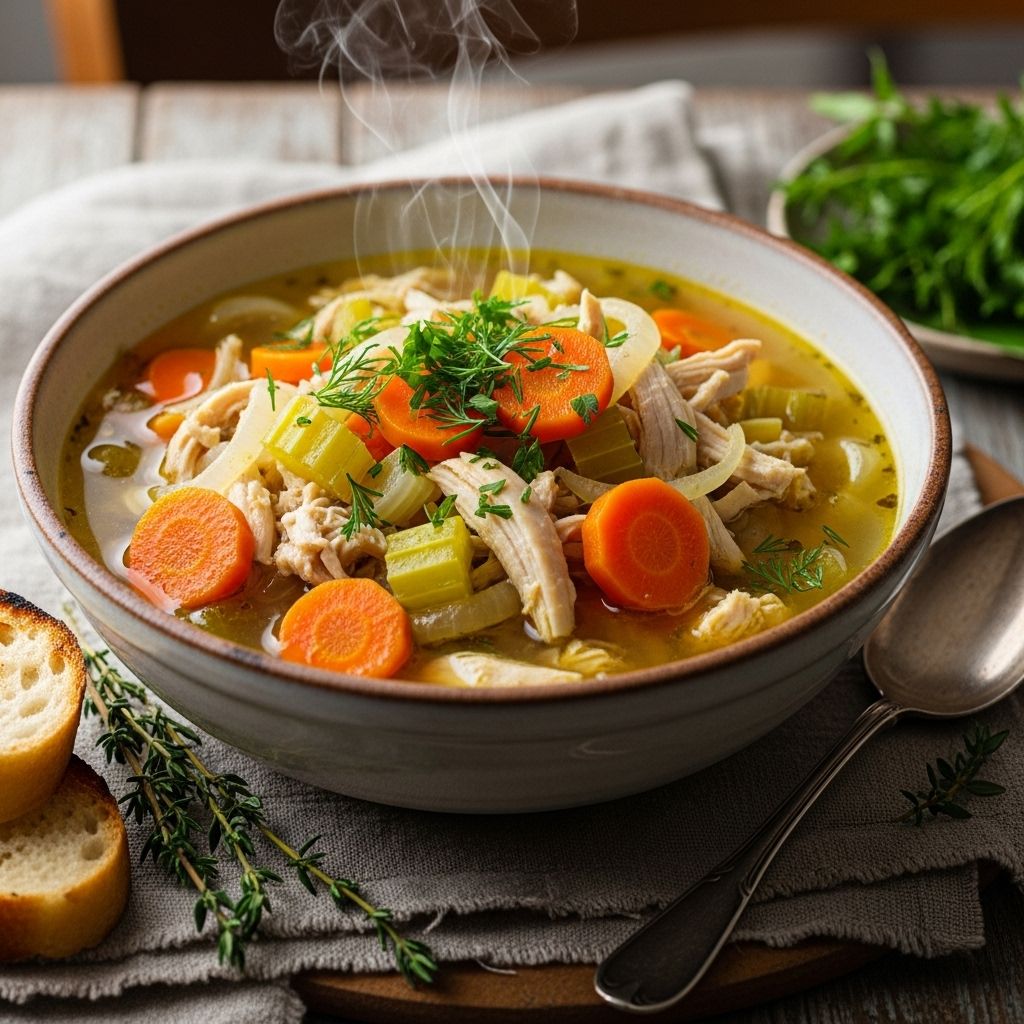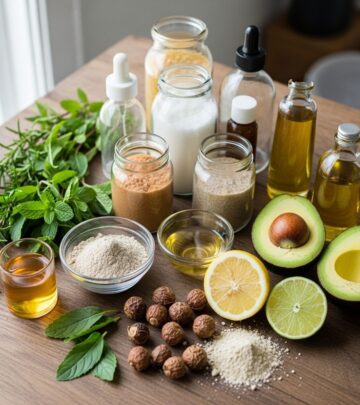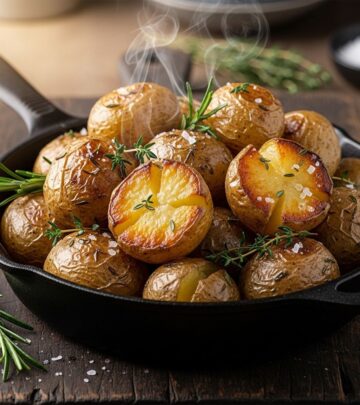Homemade Chicken Soup Recipe: Essential Comfort Food Guide
Warm up your soul with a timeless recipe filled with rich flavors and healing goodness.

Image: HearthJunction Design Team
Classic Homemade Chicken Soup: Comfort in a Bowl
There’s nothing quite as comforting as a steaming bowl of homemade chicken soup. This timeless recipe has been passed down through generations, earning its reputation as the ultimate comfort food for good reason. Whether you’re feeling under the weather, seeking warmth on a chilly day, or simply craving a wholesome meal that nourishes both body and soul, this homemade chicken soup delivers on all fronts.
Made with a whole chicken, fresh vegetables, and simple seasonings, this soup creates its own rich, flavorful broth as it cooks. The beauty of this recipe lies in its simplicity—with minimal ingredients and straightforward preparation, you’ll have a pot of liquid gold that tastes like it’s been simmering all day in a grandmother’s kitchen.
Let’s dive into how you can create this classic comfort food right in your own kitchen, with tips for perfecting your technique and making the most of every ingredient along the way.
The Magic of Homemade Chicken Soup
Before we get into the specifics of the recipe, it’s worth noting what makes homemade chicken soup so special. Unlike canned or store-bought varieties, homemade chicken soup contains no preservatives or artificial ingredients—just pure, wholesome goodness that you can feel good about serving to your family.
The slow simmering of a whole chicken creates a deeply flavorful broth that simply can’t be replicated with bouillon cubes or pre-made stock. As the chicken cooks, it releases collagen and nutrients into the water, creating a broth that’s not only delicious but also potentially beneficial when you’re feeling under the weather.
This recipe embraces the traditional approach of making both the stock and soup in one pot, allowing all the flavors to meld together beautifully while minimizing cleanup. It’s home cooking at its finest—simple, nourishing, and deeply satisfying.
Essential Ingredients for Perfect Chicken Soup
The beauty of this classic chicken soup recipe lies in its simplicity. With just a handful of fresh, wholesome ingredients, you can create a pot of soup that tastes like it’s been perfected over generations. Here’s what you’ll need to gather before getting started:
The Foundation: Chicken and Vegetables
- Whole Chicken: A 3-pound whole chicken serves as the heart of this recipe. Using a whole bird rather than pre-cut pieces allows you to create a rich, flavorful broth while ensuring tender, juicy meat for the finished soup.
- Carrots: Four large carrots, halved for the initial stock-making and later chopped into bite-sized pieces, add sweetness, color, and valuable nutrients.
- Celery: Four stalks of celery, also halved initially and later chopped, contribute an aromatic base that’s essential to classic chicken soup.
- Onion: One large onion, halved, helps build the foundational flavors of your broth, infusing it with depth and complexity.
Simple Seasonings
- Salt and Pepper: These basic seasonings allow the natural flavors of the chicken and vegetables to shine through while enhancing the overall taste of the soup.
- Chicken Bouillon Granules (Optional): While the soup develops wonderful flavor on its own, you can add bouillon granules to intensify the chicken flavor if desired.
- Water: Enough to cover all ingredients, serving as the base that transforms into your golden broth.
The simplicity of these ingredients is intentional—allowing the pure flavors of chicken and vegetables to take center stage without being overshadowed by complex seasonings or additions. This is chicken soup in its purest, most comforting form.
Step-by-Step Cooking Instructions
Creating this homemade chicken soup involves a two-phase cooking process: first making a flavorful stock, then transforming it into the finished soup. Follow these detailed steps for soup-making success:
Phase 1: Creating the Chicken Stock
- Prepare your ingredients: Rinse the whole chicken under cold water and remove any giblets from the cavity. There’s no need to cut the chicken into pieces at this stage. Wash and halve the carrots, celery stalks, and onion.
- Combine all ingredients in a large soup pot: Place the whole chicken in a large stockpot or Dutch oven. Add the halved vegetables around the chicken. The vegetables will be strained out later, so they don’t need to be chopped small at this point.
- Add water and season: Pour in enough cold water to completely cover the chicken and vegetables, typically about 10-12 cups depending on your pot size. Add a generous pinch of salt and a few grinds of black pepper.
- Bring to a boil, then simmer: Set the pot over high heat and bring the water to a rolling boil. Once boiling, reduce the heat to maintain a gentle simmer. Skim off any foam that rises to the surface using a slotted spoon.
- Cook until the chicken is falling off the bone: Cover the pot partially with a lid and let simmer for approximately 1 to 1½ hours, or until the chicken meat is incredibly tender and beginning to fall off the bones. The exact time will depend on the size of your chicken.
Phase 2: Preparing the Final Soup
- Remove and process the chicken: Once the chicken is fully cooked, carefully transfer it from the pot to a large bowl or plate. Let it cool until you can handle it comfortably. Then, remove all the meat from the bones, discarding the skin and bones. Tear or chop the meat into bite-sized pieces.
- Strain and preserve the stock: While the chicken is cooling, strain the cooking liquid through a fine-mesh sieve into another large container, catching the vegetables and any bones that may have separated during cooking. Set the vegetables aside.
- Rinse and reuse the pot: Quickly rinse out your soup pot to remove any residue, then return the strained stock to the clean pot.
- Process the vegetables: Chop the strained vegetables into smaller, bite-sized pieces. They’ll be quite soft from the long simmering, so handle them gently.
- Combine all elements: Return the chopped chicken meat and vegetables to the pot with the stock. If you prefer firmer vegetables, you can alternatively discard the cooked ones and add freshly chopped vegetables, simmering until just tender.
- Final seasoning and warming: Bring the soup back to a simmer over medium heat. Taste and adjust the seasoning with additional salt, pepper, and chicken bouillon granules if desired. Allow the soup to heat through completely, about 5-10 minutes.
Once completed, your homemade chicken soup is ready to serve! Ladle it into bowls while still steaming hot, perhaps with a slice of crusty bread on the side for dipping.
Serving Suggestions and Variations
While this classic chicken soup is perfect as is, there are numerous ways to serve it and variations to explore that can add new dimensions to this traditional favorite:
Classic Serving Ideas
- Crusty Bread Accompaniment: Serve your chicken soup with a slice of warm, crusty bread or homemade dinner rolls for dipping.
- Fresh Herb Garnish: A sprinkle of freshly chopped parsley, dill, or chives adds color and a burst of fresh flavor just before serving.
- Lemon Wedge: Offer lemon wedges on the side—a squeeze of fresh lemon juice can brighten the soup’s flavors tremendously.
Delicious Variations to Try
- Chicken Noodle Soup: Add 8 ounces of egg noodles or your favorite pasta during the last 8-10 minutes of cooking for a classic chicken noodle soup.
- Chicken and Rice Soup: Stir in 1 cup of pre-cooked rice when reheating the finished soup for added heartiness.
- Herbed Chicken Soup: Enhance the flavor profile with a bouquet garni of fresh herbs such as thyme, rosemary, and bay leaves during the stock-making phase.
- Veggie-Packed Version: Increase the nutrition by adding extra vegetables such as peas, corn, green beans, or diced potatoes in the final cooking stage.
- Spicy Chicken Soup: Add a kick with red pepper flakes, a dash of hot sauce, or sliced fresh jalapeños for those who enjoy some heat.
- Creamy Chicken Soup: Stir in ½ cup of heavy cream or coconut milk just before serving for a richer, more indulgent version.
Storage and Make-Ahead Tips
One of the greatest advantages of homemade chicken soup is that it often tastes even better the next day as the flavors continue to develop. Here’s how to properly store your soup and even prepare it in advance:
Refrigerating Chicken Soup
Allow your chicken soup to cool completely before transferring it to airtight containers. Properly stored in the refrigerator, homemade chicken soup will keep well for 3-4 days. When reheating, bring it to a full simmer on the stovetop or heat thoroughly in the microwave until steaming hot.
Freezing for Future Meals
Chicken soup freezes beautifully, making it perfect for meal prep or having on hand for when illness strikes. Here’s the best approach to freezing:
- Cool the soup completely before freezing to prevent ice crystals from forming.
- Portion the soup into freezer-safe containers or heavy-duty freezer bags in single or family-sized servings.
- Leave about an inch of space at the top of containers to allow for expansion during freezing.
- If using freezer bags, squeeze out excess air and freeze flat on a baking sheet before stacking to save space.
- Label containers with the date and contents—frozen chicken soup maintains best quality for up to 6 months.
Reheating From Frozen
To reheat frozen chicken soup, you have several options:
- Thaw overnight: Transfer the frozen soup to the refrigerator to thaw overnight, then reheat on the stovetop or in the microwave.
- Direct reheating: Place the frozen soup in a pot with a splash of water, cover, and heat over low heat, stirring occasionally, until fully thawed and hot.
- Microwave method: Use the defrost setting on your microwave to gently thaw the soup before heating it on high until thoroughly hot.
Nutritional Benefits of Homemade Chicken Soup
Beyond its comforting qualities, homemade chicken soup offers numerous nutritional benefits that make it not just good for the soul, but good for the body as well:
- Protein-Rich: The chicken provides high-quality protein essential for muscle maintenance and overall health.
- Hydration Support: The broth helps maintain hydration, especially important when fighting illness.
- Vitamin Abundance: Carrots contribute vitamin A, while celery and onions add various B vitamins and antioxidants.
- Mineral Content: The slow-simmered bone broth contains minerals like calcium, magnesium, phosphorus, and potassium.
- Anti-Inflammatory Properties: Research suggests chicken soup may have mild anti-inflammatory effects that could help ease cold symptoms.
- Easily Digestible: The long cooking process breaks down ingredients into easily digestible forms, making this soup gentle on the digestive system.
Why Homemade Beats Store-Bought Every Time
While canned and packaged chicken soups offer convenience, making your own delivers significant advantages:
- Superior Flavor: The depth and richness of homemade broth simply can’t be matched by mass-produced alternatives.
- Controlled Ingredients: You decide exactly what goes into your soup—no preservatives, excessive sodium, or additives.
- Custom Texture: Prepare vegetables and chicken to your preferred tenderness and size rather than accepting what comes in a can.
- Cost-Effective: A single whole chicken yields significantly more soup than the equivalent cost in pre-made options.
- Reduced Waste: Making soup from scratch allows you to use the entire chicken and reduce packaging waste.
Frequently Asked Questions (FAQs)
Q: Can I use chicken parts instead of a whole chicken?
A: Yes, you can use chicken parts such as thighs, breasts, or a combination. Bone-in pieces will produce a more flavorful broth than boneless pieces. For best results, use about 3 pounds of chicken parts as a substitute for the whole chicken.
Q: How can I make my chicken soup broth clearer?
A: For a clearer broth, be diligent about skimming the foam that rises to the surface during the initial simmering. Additionally, strain the finished broth through a fine-mesh sieve lined with cheesecloth to remove small particles.
Q: Can I add noodles or rice directly to the soup?
A: While you can add pasta or rice directly to the soup, they will continue to absorb liquid during storage, potentially becoming mushy. For best results, cook noodles or rice separately and add them to individual servings, or add them only to the portion you plan to consume immediately.
Q: What’s the secret to really flavorful chicken soup?
A: The key to deeply flavorful soup is patience—allowing the chicken and vegetables to simmer long enough to release their flavors into the broth. Using a whole chicken rather than boneless pieces also significantly enhances flavor, as does ensuring proper seasoning with salt throughout the cooking process rather than just at the end.
Q: Why is chicken soup often recommended when you’re sick?
A: Chicken soup combines several elements that may help during illness: warm broth helps clear nasal passages and provides hydration, the steam can relieve congestion, and research suggests chicken soup may have mild anti-inflammatory properties that could help ease cold symptoms. The easily digestible nutrients also provide support when appetite may be reduced.
This classic homemade chicken soup recipe is more than just a meal—it’s a tradition that connects us to generations of home cooks who understood the power of simple, nourishing food. Whether you’re making it to nurse someone back to health or simply to enjoy a satisfying dinner, this soup delivers comfort in every spoonful. As the enticing aroma fills your kitchen, you’ll understand why chicken soup has earned its reputation as the ultimate comfort food across cultures and throughout history.
References
- https://www.allrecipes.com/recipe/8814/homemade-chicken-soup/
- https://www.allrecipes.com/recipe/26460/quick-and-easy-chicken-noodle-soup/
- https://www.allrecipes.com/recipe/26472/the-best-chicken-soup-ever/
- https://www.allrecipes.com/recipe/22670/regular-chicken-soup/
- https://www.youtube.com/watch?v=zcgYweT_Gys
Read full bio of Shinta












